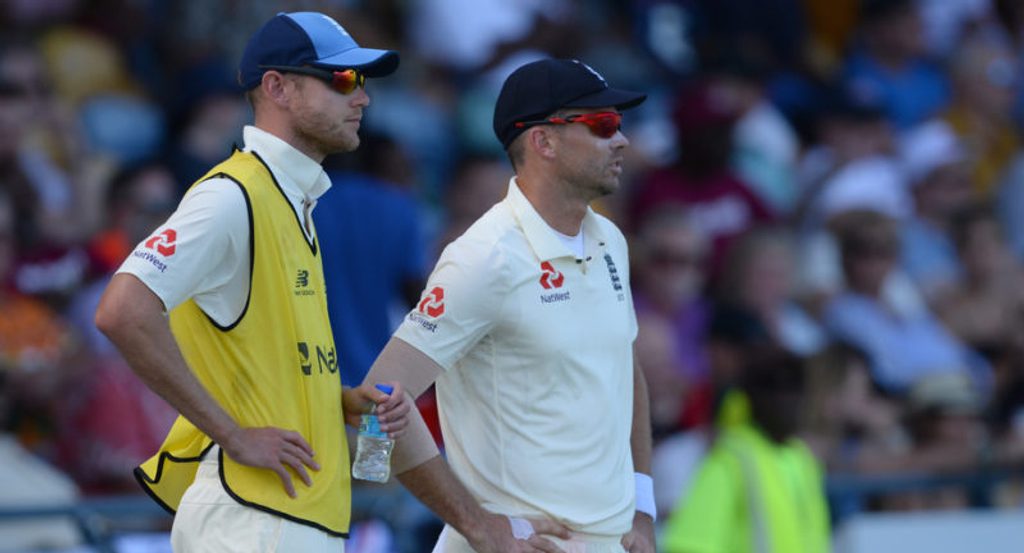
Despite a heavy defeat to West Indies in the first Test, Taha Hashim believes England should be given some credit for their risk-taking selections.
Fortune favours the brave … sometimes. West Indies’ 381-run victory in the first Test arrived in the most fitting of circumstances. The bowler, Roston Chase. The batsman, Sam Curran. England were 246 for 9, 382 runs behind the impossible win, a day and a bit away from the unlikely draw. And yet, that youthful vigour, that hearty aggression – symbolic of Root’s side – remained within the 20-year-old Curran.
As Chase strode towards the crease, Curran advanced down the track still looking to attack for runs. The tall, languid Chase, with seven wickets to his name, wasn’t to be outfoxed. He darted the ball down the leg-side, leaving Curran perplexed. Shai Hope obliged with a quick-fire stumping, sealing a staggering thrashing.
West Indies win by 381 runs.
Roston Chase, who had just 42 wickets from 26 Tests before this game, finishes with figures of 8-60.
A thoroughly deserved victory for the West Indies, who comprehensively outplayed England in every department. #WIvENG | #WIvsENG pic.twitter.com/sqAG1GUtlv
— Wisden (@WisdenCricket) January 26, 2019
A brief passage of play told a much larger story, for whatever England did over the course of four days in Barbados, little went their way. Amidst the backdrop of Shimron Hetmyer’s exuberance with the bat, Kemar Roach’s thrilling pace, and Jason Holder’s monumental knock at No.8, there was the constant soundtrack of pundits voicing concern over England’s selection mishaps.
The decision to drop Stuart Broad and play both Curran and Adil Rashid was one that staggered many. On commentary, Nasser Hussain spent much of day one in disbelief at the decision to leave out a man with 433 Test wickets to his name. For the BBC, Jonathan Agnew, reflecting after the defeat, posed the argument: “Who knows what might [have] happened if Broad had helped dismiss West Indies cheaply on the first day.”
 Broad’s (left) omission from the line-up raised a few eyebrows
Broad’s (left) omission from the line-up raised a few eyebrows
Root conceded that the management group had made some selection errors, telling Sky Sports in his post-match review: “I hold my hand up, we might have got it wrong on this occasion, but we shouldn’t be scared of trying things and finding ways of winning we might not have done in the past.”
And it is from that soundbite that there should be praise for Root rather than castigation.
What was most refreshing about England’s 3-0 series victory in Sri Lanka was the desire to be bold and shake the rule book up a little bit. The devotion towards the sweep shot, the brave decision to employ only one of the Anderson-Broad pair, the use of Jonny Bairstow at No. 3 – these were gambles that paid off with fantastic returns.
 Thinking outside the box was a key aspect of England’s series win in Sri Lanka
Thinking outside the box was a key aspect of England’s series win in Sri Lanka
The use of Rashid and Curran in this match was a worthy punt following in the vain of the positive frame of mind that had been cultivated in Sri Lanka. While Jack Leach would have served as a safety valve with his more predictable left-arm spin, the appetising prospect of Rashid finding turn with his leg-break was a risk worth taking. With Curran’s Test record of seven wins from seven, it proved understandable to include the Surrey left-armer.
It didn’t take long to acknowledge that both inclusions were questionable. The seamer struggled for both swing and control across the first day, while Rashid found little purchase from the Bridgetown pitch. His second-innings return would see him bowl just nine very expensive overs. The events of the second day, with Roach and Holder wreaking havoc, all but confirmed that the inclusion of Broad may well have served England better. Despite an opticians company serving as one of England’s sponsors, it was the home side who read the pitch accurately.
And still, such a harrowing experience should not cause Root to throw away his mantra of inventiveness. At the top of the selection think-tank, Ed Smith’s boldness as chief selector has been a hallmark of his reign; the radical inclusions of Jos Buttler and Rashid on white-ball form were ones that paid off. Even the decision to hand Curran a debut last summer was a risk, after a 2017 County Championship season saw him collect just 25 wickets from 13 matches at an average of 47.16.
A deepening frustration of England’s Ashes defeat in 2017/18 was the rotating churn of right-arm seamers operating at similar speeds, combining to form an unthreatening bowling machine for Australia’s batsmen to make hay. Following on from the appointment of Smith, Root’s captaincy has emerged to be more out-of-the-box, seen across three matches in Sri Lanka.
 Adil Rashid struggled across both innings
Adil Rashid struggled across both innings
After a defeat of such magnitude, it is worth remembering that England have won seven of their last nine Tests with a dogma of experimentation. From the viewpoint of a neutral, one hopes that they continue to throw surprises at the door, for this remains an enchanting team to watch, capable of both brilliance and maddening destruction. In a year which will hopefully see cricket find more of a spotlight amongst back pages – with both an Ashes series and World Cup on home shores – a desire for defensive pragmatism, be it with selection or style of play, should be avoided.
Regardless of the decision to leave out Broad, it was England’s batsmen who failed in this Test, succumbing to 77 all out. Mistakes were made across the last few days, and with Root’s words after the game, hands have been held up. While the word “leave” plagues the nation at this moment in time, Root’s principles of thinking a little differently and dreaming a little boldly should firmly remain.








